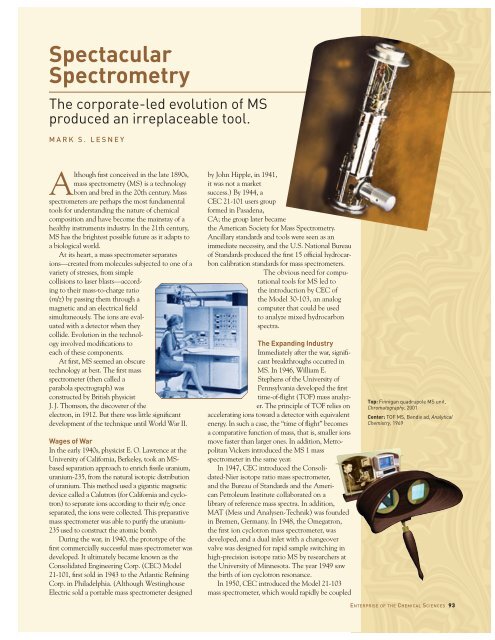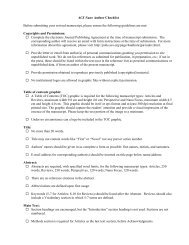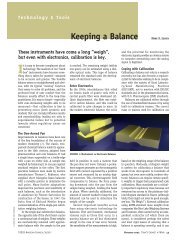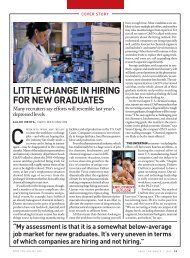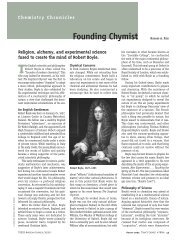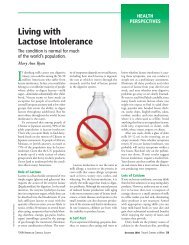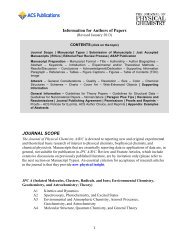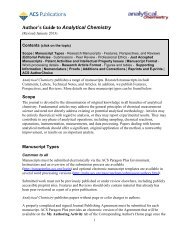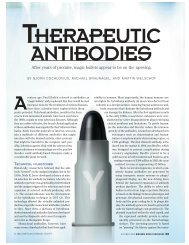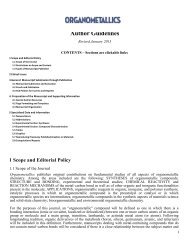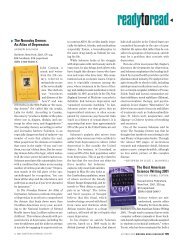Spectacular Spectrometry - American Chemical Society Publications
Spectacular Spectrometry - American Chemical Society Publications
Spectacular Spectrometry - American Chemical Society Publications
You also want an ePaper? Increase the reach of your titles
YUMPU automatically turns print PDFs into web optimized ePapers that Google loves.
<strong>Spectacular</strong><br />
<strong>Spectrometry</strong><br />
The corporate-led evolution of MS<br />
produced an irreplaceable tool.<br />
MARK S. LESNEY<br />
Although first conceived in the late 1890s,<br />
mass spectrometry (MS) is a technology<br />
born and bred in the 20th century. Mass<br />
spectrometers are perhaps the most fundamental<br />
tools for understanding the nature of chemical<br />
composition and have become the mainstay of a<br />
healthy instruments industry. In the 21th century,<br />
MS has the brightest possible future as it adapts to<br />
a biological world.<br />
At its heart, a mass spectrometer separates<br />
ions—created from molecules subjected to one of a<br />
variety of stresses, from simple<br />
collisions to laser blasts—according<br />
to their mass-to-charge ratio<br />
(m/z) by passing them through a<br />
magnetic and an electrical field<br />
simultaneously. The ions are evaluated<br />
with a detector when they<br />
collide. Evolution in the technology<br />
involved modifications to<br />
each of these components.<br />
At first, MS seemed an obscure<br />
technology at best. The first mass<br />
spectrometer (then called a<br />
parabola spectrograph) was<br />
constructed by British physicist<br />
J. J. Thomson, the discoverer of the<br />
electron, in 1912. But there was little significant<br />
development of the technique until World War II.<br />
Wages of War<br />
In the early 1940s, physicist E. O. Lawrence at the<br />
University of California, Berkeley, took an MSbased<br />
separation approach to enrich fissile uranium,<br />
uranium-235, from the natural isotopic distribution<br />
of uranium. This method used a gigantic magnetic<br />
device called a Calutron (for California and cyclotron)<br />
to separate ions according to their m/z; once<br />
separated, the ions were collected. This preparative<br />
mass spectrometer was able to purify the uranium-<br />
235 used to construct the atomic bomb.<br />
During the war, in 1940, the prototype of the<br />
first commercially successful mass spectrometer was<br />
developed. It ultimately became known as the<br />
Consolidated Engineering Corp. (CEC) Model<br />
21-101, first sold in 1943 to the Atlantic Refining<br />
Corp. in Philadelphia. (Although Westinghouse<br />
Electric sold a portable mass spectrometer designed<br />
by John Hipple, in 1941,<br />
it was not a market<br />
success.) By 1944, a<br />
CEC 21-101 users group<br />
formed in Pasadena,<br />
CA; the group later became<br />
the <strong>American</strong> <strong>Society</strong> for Mass <strong>Spectrometry</strong>.<br />
Ancillary standards and tools were seen as an<br />
immediate necessity, and the U.S. National Bureau<br />
of Standards produced the first 15 official hydrocarbon<br />
calibration standards for mass spectrometers.<br />
The obvious need for computational<br />
tools for MS led to<br />
the introduction by CEC of<br />
the Model 30-103, an analog<br />
computer that could be used<br />
to analyze mixed hydrocarbon<br />
spectra.<br />
The Expanding Industry<br />
Immediately after the war, significant<br />
breakthroughs occurred in<br />
MS. In 1946, William E.<br />
Stephens of the University of<br />
Pennsylvania developed the first<br />
time-of-flight (TOF) mass analyzer.<br />
The principle of TOF relies on<br />
accelerating ions toward a detector with equivalent<br />
energy. In such a case, the “time of flight” becomes<br />
a comparative function of mass, that is, smaller ions<br />
move faster than larger ones. In addition, Metropolitan<br />
Vickers introduced the MS 1 mass<br />
spectrometer in the same year.<br />
In 1947, CEC introduced the Consolidated-Nier<br />
isotope ratio mass spectrometer,<br />
and the Bureau of Standards and the <strong>American</strong><br />
Petroleum Institute collaborated on a<br />
library of reference mass spectra. In addition,<br />
MAT (Mess und Analysen-Technik) was founded<br />
in Bremen, Germany. In 1948, the Omegatron,<br />
the first ion cyclotron mass spectrometer, was<br />
developed, and a dual inlet with a changeover<br />
valve was designed for rapid sample switching in<br />
high-precision isotope ratio MS by researchers at<br />
the University of Minnesota. The year 1949 saw<br />
the birth of ion cyclotron resonance.<br />
In 1950, CEC introduced the Model 21-103<br />
mass spectrometer, which would rapidly be coupled<br />
Top: Finnigan quadrupole MS unit,<br />
Chromatography, 2001<br />
Center: TOF MS, Bendix ad, Analytical<br />
Chemistry, 1969<br />
ENTERPRISE OF THE CHEMICAL SCIENCES 93
SPECTACULAR<br />
SPECTROMETRY<br />
TIMELY TANAKA<br />
The 2002 Nobel Prize in Chemistry was given<br />
to three pioneers of methods for identification<br />
and structure analyses of biological macromolecules.<br />
Among them was Koichi Tanaka<br />
(Shimadzu Corp.), who was awarded the prize<br />
for his development of MALDI—in part through<br />
a fortuitous mistake in his laboratory. While<br />
attempting to develop an optimal matrix to<br />
contain a sample to be ionized by a laser blast,<br />
Tanaka mistakenly mixed glycerin instead of<br />
acetone with cobalt. According to the<br />
Shimadzu website, “Tanaka—part of a team<br />
noted for its faith in trial and error—came to<br />
the conclusion that even this presumably<br />
wasteful mixture, like any other, might have<br />
some potential—and might even be the ‘right<br />
one’—and he set it on a sample plate and the<br />
road to becoming a miracle matrix.”<br />
One of Tanaka’s two co-winners was John<br />
B. Fenn, who was awarded the prize for his<br />
development of ESI. Together with MALDI, ESI<br />
has helped to make MS not only a viable but an<br />
ideal tool for biological analysis.<br />
Above: Artist’s rendering of MALDI,<br />
Modern Drug Discovery, 2003<br />
94 ENTERPRISE OF THE CHEMICAL SCIENCES<br />
to heated inlet systems capable of allowing gasliquid<br />
samples to be introduced easily. In 1953,<br />
Wolfgang Paul published the first papers on<br />
quadrupole MS and ion-trap detectors. Quadrupole<br />
filters used a quadrupolar field to manipulate<br />
single ions or ranges of ions based on their m/z,<br />
thus acting as true mass filters.<br />
In 1956, Roland Gohlke and Fred McLafferty<br />
first demonstrated GC/MS using a TOF mass spectrometer<br />
(Model 12-101) developed by the Bendix<br />
Aviation Corp. Also in 1956, MS was first used to<br />
identify an organic compound by bombarding the<br />
compound’s vapor, at a pressure of 10 –5 –10 –6<br />
mmHg, with electrons having energies of 50–100<br />
eV. This process broke down the molecules of the<br />
compound to form reproducible positive, negative,<br />
and neutral fragments, making it possible to identify<br />
organic impurities in a sample without any<br />
preconcentration of the impurity.<br />
Perhaps the key business trend of the 1960s was<br />
that of increased competition as MS gained popularity<br />
and expanded its forms and as more and<br />
more companies began manufacturing and distributing<br />
the instruments.<br />
In 1962, the first commercial quadrupole mass<br />
spectrometer was sold to<br />
NASA by Electronics Associ-<br />
ates, Inc. (EAI). In a clever<br />
circumvention of a ban on<br />
instrument exhibits at the<br />
1963 annual meeting of the<br />
<strong>American</strong> <strong>Society</strong> for Testing<br />
and Materials, Applied<br />
Physics Corp. exhibited its<br />
MAT CH4 MS unit to attendees<br />
who were willing to walk<br />
to a bar across the street from<br />
the conference.<br />
In 1964, Jeol produced its<br />
first mass spectrometer; and<br />
throughout the 1960s,<br />
PerkinElmer became a significant<br />
force in the MS market<br />
in the United States, acting as<br />
the distributor of Hitachi<br />
units. Competition continued<br />
to expand as, in 1967, the<br />
Finnigan Co. (acquired by<br />
Thermo in 1990) was formed<br />
by Robert Finnigan (formerly<br />
of EAI) to take advantage of<br />
the potential he saw in<br />
quadrupole GC/MS and the<br />
advancements computers would provide to MS<br />
instruments. That company’s introduction of the<br />
first commercial quadrupole GC/MS came just one<br />
year later. Also in 1967, MAT, which came out<br />
with the CH5 that same year, was acquired by Varian,<br />
becoming Varian MAT. Significant to the<br />
biological future of MS, in 1968, electrospray<br />
ionization (ESI) at atmospheric pressure was developed<br />
by Malcolm Dole and colleagues, although<br />
the technique would not be routinely used for two<br />
more decades.<br />
In 1967, PerkinElmer introduced its own mass<br />
spectrometer, Model 270—the first magnetic<br />
double-focusing GC/MS. By the late 1960s,<br />
Hewlett-Packard had entered the GC/MS<br />
market—and would continue its involvement<br />
through the 1990s. These instruments were a<br />
strong reflection of how the marriage of GC and<br />
MS would continue as the most powerful combination<br />
for organic analysis.<br />
Also in the 1960s, the first secondary-ion MS,<br />
or SIMS, instrument was constructed under a<br />
NASA contract to analyze moon rocks. In SIMS,<br />
a sample surface is bombarded with a primary ion<br />
beam, followed by MS of the emitted secondary<br />
ions. The instrument was copied and marketed,<br />
creating an expanding demand for SIMS in the<br />
decades to follow, especially in the developing<br />
electronic materials industry.<br />
That ’70s Flow<br />
By the early 1970s, GC/MS was the technique of<br />
choice for monitoring illegal drug trafficking and<br />
use. With the development of the environmental<br />
movement prompted by Earth Day and the establishment<br />
of the Environmental Protection Agency<br />
(EPA), the issue of pollution monitoring became<br />
critical. An early example of this was the use of<br />
DuPont’s DIMASPEC (digitized GC/MS) in 1971<br />
to detect contaminant diethylstilbestrol in beef. In<br />
1978, EPA accepted Finnigan’s GC/MS system as a<br />
standard means of analyzing pollutants. Because of<br />
this endorsement, the company came to dominate<br />
the global market, even though units were priced<br />
in the $150,000 range. Such sales indicate the<br />
impact of the environmental movement in the<br />
1970s—an impact that continues today—on the<br />
overall market for analytical instruments.<br />
Throughout the decade, MS continued to<br />
develop new incarnations. In 1974, Fourier transform<br />
ion cyclotron resonance was introduced. By<br />
1977, Finnigan was offering an early line of<br />
LC/MS systems.<br />
New companies were formed to take advantage<br />
of new technologies. For example, Comstock was<br />
founded in Oak Ridge, TN, in 1979 by physicists<br />
Robert N. Compton and John A. D. Stockdale.<br />
Although their initial product was an electrostatic<br />
energy analyzer, they became noted for their TOF<br />
MS line introduced in 1987, and they would<br />
continue to develop specialized TOF instruments<br />
thereafter.<br />
The ’80s and ’90s<br />
This decade saw the development of one of the<br />
most powerful inorganic analysis techniques.<br />
PerkinElmer became involved in inductively<br />
coupled plasma (ICP)-MS when through a joint<br />
venture with SCIEX, the company helped to<br />
develop and market the ELAN 250, the first ICP-<br />
MS instrument for commercial applications.
In 1987, PerkinElmer SCIEX introduced the<br />
ELAN 500, the first ICP-MS system with platinum<br />
cones and an inert sample introduction system.<br />
The company went on to launch the ELAN 5000,<br />
the first turbomolecular-pumped ICP-MS instrument,<br />
in 1990, and later the ELAN 6000, the first<br />
ICP-MS system with a simultaneous automatic<br />
extended dynamic range detection system.<br />
New companies were unveiled and changes<br />
took place in corporate structure through mergers<br />
and acquisitions. In 1980, the Bruker Daltonics<br />
Corp. formed as part of the global Bruker organization.<br />
The company’s roots were in the German<br />
Bruker-Franzen Analytik GmbH and the Swiss<br />
Spectrospin AG. These companies developed<br />
mobile detectors and mass spectrometers for physical<br />
chemistry. In 1981, Varian MAT was acquired<br />
by Finnigan, becoming Finnigan MAT.<br />
In 1982, Cambridge Mass <strong>Spectrometry</strong> (CMS)<br />
was spun off from Cambridge Consultants Ltd.<br />
(CCL, a division of Arthur D. Little). In 1987,<br />
CMS became a wholly owned subsidiary of Kratos<br />
Analytical, which came under the control of<br />
Shimadzu Corp. of Japan in 1990. CMS produced<br />
surface analysis instruments using quadrupole and<br />
TOF-SIMS technology. In 1992, the company<br />
Kore was founded by a “core” of engineers and<br />
accountants at CMS who decided not to transfer to<br />
Manchester, U.K., as part of a cost-cutting effort to<br />
merge the CMS products with Kratos.<br />
MALDI and More<br />
Because MS techniques were typically too harsh for<br />
most biomolecules, it wasn’t until the development<br />
and routine deployment of the so-called soft ionization<br />
techniques—ESI (which was only then achieving<br />
popularity) and matrix-assisted laser<br />
desorption/ionization (MALDI)—that MS became<br />
a key tool in modern biology. MALDI was developed<br />
in 1985 (see sidebar). In 1988, the LAMS-<br />
50K, the first commercial MALDI-TOF MS instrument,<br />
was released by Shimadzu. MALDI rapidly<br />
became an important biological analysis technique,<br />
such that by 1990, protein structure studies were<br />
being performed using MALDI techniques.<br />
Founded in 1987 in Branford, CT, Analytica<br />
began as a spin-off from Yale University to<br />
commercialize ESI MS. But it wasn’t until 1989<br />
that ESI was first reported to be useful for studying<br />
large biomolecules in a significant article published<br />
in Science (vol. 246, pp 64–71) by John B. Fenn<br />
and colleagues (see sidebar).<br />
New MS companies continued to proliferate.<br />
Bergmann Messgeraete Entwicklung KG was<br />
founded in 1991 by Thorald Bergmann to develop<br />
and produce advanced TOF mass spectrometers<br />
based on an instrument he designed as his<br />
Ph.D thesis.<br />
Burgeoning Bio<br />
If anything were to define MS in the 1990s,<br />
perhaps most notable would be the explosive<br />
growth of biological applications. For example, in<br />
1992, low-level peptide analysis became possible,<br />
and by 1993, driven in part by the demands of the<br />
burgeoning Human Genome Project, limited<br />
oligonucleotide sequencing became possible. By<br />
1996, MS of viruses was being attempted. All of<br />
this was becoming possible as MS became ever<br />
more linked to liquid chromatography—HPLC.<br />
For example, in 1996, Waters made its<br />
largest acquisition up to that point by acquiring<br />
Micromass of Manchester, U.K. The acquisition<br />
achieved its goal, immediately putting Waters<br />
in the forefront of the market for LC/MS<br />
instruments.<br />
With similar intent, in 2001, Varian expanded<br />
its MS technology by acquiring Bear Instruments<br />
of Santa Clara, CA, in order to increase its participation<br />
in the growing life science applications<br />
market. Bear produced analytical instruments<br />
based on triple-quadrupole MS/MS technology,<br />
including triple-quadrupole GC/MS/MS and<br />
LC/MS/MS systems. Quadrupole LC/MS/MS is a<br />
critical technology to the pharmaceutical industry<br />
for assessing ADME (absorption, distribution,<br />
metabolism, and excretion) parameters for drug<br />
development. Similarly, in late 2002, Waters and<br />
Micromass merged completely, with the stated<br />
intention of responding more readily to the<br />
increasing demand for LC/MS.<br />
Future of MS<br />
Overall, MS is still an evolving technology. Its<br />
limits are being pushed and adapted to the latest<br />
demands of biotechnology with innovations such<br />
as tandem expansions and multiple connections<br />
to HPLC. With newer portable systems, such as<br />
the Inficon (formerly Leybold Inficon) Hapsite,<br />
being devised, the classic GC/MS instrument also<br />
remains strong—adapting to the world of bioterrorism.<br />
It seems likely that MS will remain for all<br />
time the stand-alone staple of modern chemical<br />
analysis, as well as the ultimate chromatography<br />
detector—expanding the practical and theoretical<br />
range of chemistry as a whole to the benefit of<br />
an unlimited set of applications, now and in the<br />
future. ◆<br />
SPECTACULAR<br />
SPECTROMETRY<br />
Above: GC/MS, Finnigan ad, Analytical<br />
Chemistry, 1971<br />
ENTERPRISE OF THE CHEMICAL SCIENCES 97


